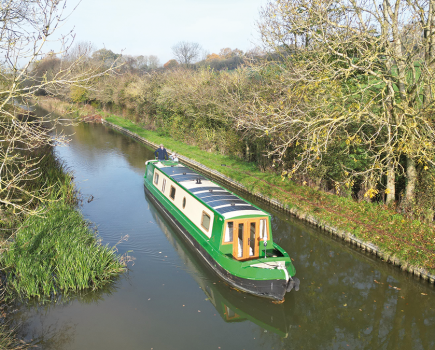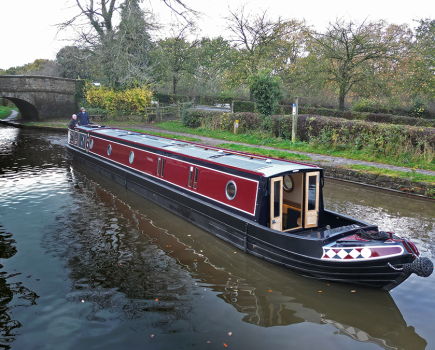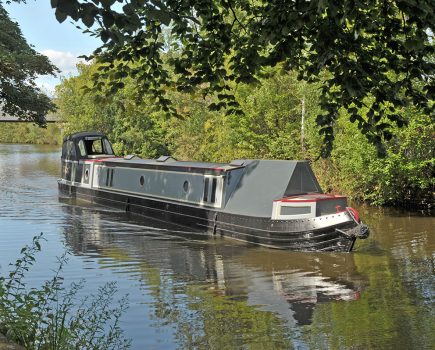Spica is one of the brightest stars in the night sky – an apt name for a superbly equipped and beautifully built modern version of a Northwich ‘Star Class’ boat

When you’re having a boat built, your level of involvement in the process is really up to you. We’ve met people who’ve made all their choices on layout, equipment and fittings and then left it pretty much up to the builder to get on with it.
At the other end of the spectrum are Alistair and Georgina Hodgson. They wanted a boat based on the shape of a working boat with a vintage engine, but a comfortable modern interior. So they chose their shell builder, sourced an engine with real history, and commissioned Sandhills to fit it out.

In addition, they travelled hundreds of miles up and down the country looking for just the right wood for part of the fit-out, scoured the Internet for equipment suppliers and even designed some of their own furniture.
In short, they took a very hands-on approach from start to finish. And the benefits are clear to see, because Spica is really rather special.

EXTERIOR
When you’re building a shell that’s a replica of a working boat you need someone who really knows what they’re doing. The Hodgsons commissioned Roger Farrington and his son Michael of Ivybridge Marine at the bottom lock in Braunston who used the original plans of a small Northwich Star Class (the slightly shallower version of the boats built by Yarwoods) to make sure the shape and measurements were all just right – just a bit shorter at 57ft long – and he’s undoubtedly succeeded.
There’s a recognisably small Northwich bow, a subtle lift to the cabin at the stern and three tunnel bands. There is also plenty of nice detailing too, such as the slight protrusion at the top of the back cabin, which also has a flat handrail, while the T-stud at the bow is probably one of the biggest you’ll ever see.

In fact, the whole boat is exceptionally solidly built, using thicker steel than is normal these days. The baseplate is 12mm rather than 10, the hull sides are 8mm instead of 6 and the cabin sides and roof are both 5mm. The quality of the workmanship is excellent, with smooth cabin sides and crisp edges. It really is a very well built boat.
Of course, a real Northwich boat would have had an open hold not a cabin, so it was important to make sure the cabin looked right.

Alistair and Georgina would ideally have liked the forward bulkhead to be a little further forward to give more living space, but Roger Farrington knew exactly where it should be in relation to the curves of the bow and wouldn’t let them move it. He did allow one change though, moving the cratch board forward by two inches to give a slightly bigger well deck.
The fact that a working boat wouldn’t have had a full-length cabin played a part in the colour scheme. Alistair wanted the cabin to disappear as much as possible, so he opted for a grey paint in a satin finish. This contrasts with the scheme on the back cabin, which is the red and blue Coronation livery of the Grand Union Canal Carrying Company, dating from 1937. Purists might notice that the phone number painted on the side is incorrect – 3107 is actually Alistair and Georgina’s wedding anniversary.

The couple have tried to disguise other modern accessories, too. There are three solar panels on the roof, but you’d hardly notice because they’re self-adhesive and flat, with the wiring hidden underneath. A black oblong the same size and shape, has been painted on the roof underneath the plank and pole stand, reinforcing the suggestion that the panels are just part of the paint scheme.
The cratch cover has an extra panel to cover the cratch board and its triangular windows, and there’s a flap either side for the shore power cable and hose pipe to pass through. There are water filling points each side complete with hose fixings (much more hygienic than poking the end of a hose pipe down a filler).

This is a gas-free boat, but there’s still a locker in the nose. The well deck gives access to another locker which houses the bow thruster and its batteries. This locker is separated by bulkheads from the rest of the boat, so even if the tube failed, the water would be contained.
The deck itself has lockers either side for storage and seating, and there’s a handy drop-down table that opens up to a good size, and even has a curved extension to complete the shape. Under gunwale and overhead lighting make this a great space for al fresco dining.

All the exposed woodwork, such as the locker tops, door linings and side hatch linings, is made from iroko, a hardwood that’s resistant to water.
A small black dome mounted discreetly on the roof is a GPS tracker of the sort used by lorries. It means family members can log-on to a website to see where Alistair and Georgina are; inside the boat there’s a button that can provide location information to the emergency services if necessary

LAYOUT AND FIT-OUT
Spica has a traditional layout with a back cabin and engine room at the stern. Next comes a walk-through shower room and the cabin, with the galley and saloon at the bow.

The fit-out of the forward part of the boat uses oak and is typical of the high quality and style Sandhills are known for. There’s shadow gap tongue and groove vertically below the gunwales, and diagonal above, for plenty of texture. The floor in the forward part of the boat is Karndean in an oak finish.
The engine room and back cabin, though, are fitted out in pitch pine, reclaimed from a chapel in Wales. It came in huge and heavy beams which had to be cut down into planks and looks beautiful.

SALOON
Stable doors lead from the well deck and they’re fitted with very neat opening oval portholes. Inside, there’s a neat Hobbit stove on a raised hearth with smart glass tiles behind to one side, while on the opposite side, there’s a curved cupboard, complete with a beautifully made door.
In fact, the joinery throughout the boat is of the highest quality; all the doors are substantial and there’s great detailing, such as the inlaid stringing which has become something of a Sandhills trademark.

Ventilation from outside is routed into the boat under the stove and the cupboard. These spaces also have finrads fitted, so the fresh air is warmed before it comes into the boat.
A run of cupboards, one containing a flatscreen TV, goes down one side of the boat. Opposite this is perhaps the highlight of the saloon – the sofa. Alistair wasn’t satisfied with any of the convertible sofas on the market, so he designed his own. As well as looking very stylish with beautifully shaped arms and rounded corners to match the The diesel-fired range is fabulous and surprisingly practical for a boat rest of the woodwork, it’s very clever. Each side can be extended to a lounger, using a pull-out section and an extra cushion stored inside; the backrest can be moved to convert it into a bed and there are flip-up tables at each end.

There isn’t room for a full dinette, but Alistair still wanted to be able to sit at a table to eat. So there’s a flip-up table under the gunwale, with a couple of folding chairs stowed behind the sofa.
GALLEY

The galley is dominated by a diesel-fired range by Sandyford which, as well as the two hot plates and oven, provides hot water and heating. It was chosen because it has two burners, so you can cook without having to have the heating on, and vice versa.
Georgina says it heats up very quickly and is ready to use in about ten minutes. There’s a hood with a light above which also hides a dog leg in the flue to ensure the chimney is in the centre of the roof. Tiles behind add an element of colour.

The galley is compact, but has all you need. There’s enough storage, and a clever pull out can unit. The fridge is a 240-volt model by Lec, in black. The sparkly granite worktop has a stainless steel sink with a milled drainer, and the tap includes a filtered water supply. There are LED lights in the kick-boards.
CABIN
The bed is inline and has three big drawers in the base. The calorifier is also hidden in the space. Above the bed, high level cupboards include some clever reading lights; they’re dimmable LEDs and clicking the switch twice turns them red which provides to enough light to see by if you get up in the night, without waking up your partner. Talking of red, the radiator colour has been matched to the galley range.

Set into the ceiling there’s a flip-down TV screen. Right at the foot of the bed a wardrobe has plenty of hanging space. The door to the shower room is recessed into the side of the unit; when it’s open, it reveals a chest of drawers in the lower half of the unit and a radio which is zoned throughout the boat. The door also has a full-length mirror on the back.
SHOWER ROOM

The first thing that strikes you here is a sense of glamour, thanks to sparkly black tiles on the floor, with LED lights set into them. The 800mm quadrant shower has black and white laminate walls and a smart shower unit. Alongside there are shelves and cupboards, with the lower one giving access to the shower pump.
The basin unit has been designed to take up as little space as possible, so the basin is a black glass bowl, mounted on a curved grey Corian shelf. There’s a mirror above. Alongside is a cupboard including a shaver point, while another one below (which gains its depth by borrowing some space from the bedroom wardrobe) houses a small Candy washing machine.

The loo is a Johnson Pumps macerating unit. The holding tank is under the floor of the back cabin.
ENGINE ROOM
The style of the boat changes when you go through to the engine room. Here, the walls are lined with the reclaimed pitch pine from the Welsh chapel, which has been given a waxed finish. There are also splashes of colour, such as the red trim on some panels, which give just the right amount of decoration.

Everything modern is hidden away, so the fuse panel, inverter and switches are in cupboards under the gunwale. The batteries are under the floor. It makes sense, because nothing should distract from the star of the show, the vintage Kromhout engine. It’s the Dutch version of a Gardner, built by Kromhout under licence. It carries its production number so Alistair was able to contact the Kromhout museum in Rotterdam where the curator, Han Mannaert, provided him with plenty of history, including copies of the original paperwork.
The engine was built in 1942 and went to the Dutch East Indies as a generator. At the end of the war it was installed in a lifeboat in the Dutch naval ship Abraham Crijnssen, which had been the last ship to escape the region after a Japanese attack, disguised as a tropical island!

After the ship was decommissioned in the 1960s, the engine found its way into a Dutch barge. An owner of that boat eventually wanted a more powerful engine, so it was swapped by Tony Redshaw who reconditioned it.
BACK CABIN

The back cabin is built to the measurements of the original small Northwich, so has everything you’d expect, such as a drop-down table, a knife drawer and a bed hole (which provides the boat’s third sleeping area). There’s also an Epping stove and a gimbal lamp. But there’s plenty you wouldn’t expect, such as LED lighting overhead and under the gunwales, and a built-in self pump-out kit hidden in one of the cupboards. Alistair also has a clever attachment to the stern stairs to hold a vice for wood and metalwork.
Set into the steerer’s step are two gold crowns. One is from 1937, the other from 2014, marking the boat’s heritage and modernity.

The pitch pine is lovely, and works well with the traditional decoration. The quality of the joinery by Sandhills is fantastic. For an example, just look at the lining of the bullseye in the ceiling, made from little blocks of wood.
TECHNICAL
Aside from the Kromhout engine, the technical side of this boat is reasonably straightforward. One thing an original working boat wouldn’t have had is a bow thruster; this one is a 95kgf electric model by Vetus. Domestic electrical power is provided by four 160Ah batteries, and there’s a 2.2kW Mastervolt Mass Combi inverter.

One addition, which stems from Alistair’s experience in the haulage industry, is the provision of a couple of Anderson connectors, so external items can be powered from the boat.
ON THE WATER

It would be hard to think of a more pleasurable way of being out on the water than using this boat. The engine sounds great and the view from the helm is superb. The traditional controls, made by Tony Bate who’s based at Norton Canes, work well (and look great too).
But perhaps even more important is that this boat handles exceptionally well. It’s a deep, heavy boat, but is remarkably nimble. Push the tiller over and (assuming you’ve got enough water underneath you) it turns on a sixpence. This is one of the best handling boats we’ve steered.
CONCLUSION
Spica is a remarkable. It has a superb shell that really does look like the small Northwich it’s based on. It has an engine dripping in history and a top-drawer fit-out. There’s design flair everywhere.
Of course, a boat with such a high spec isn’t going to be cheap. The shell cost in excess of £40,000 and the Sandhills fit-out was in the region of £90,000. The vintage engine cost £15,000. In total, the Hodgsons say they’ve spent around £170,000 with a few more bills to settle; the boat has an insurance value of £195,000. But it’s a boat worth every penny. In short, Spica is a real star.
THE OWNERS
Alistair Hodgson sailed dinghies when he was young, before moving on to yachts. But Georgina became increasingly tired of getting cold and wet, and having had canal holidays in the past, it encouraged him to swap the sea for the cut. Needless to say, he took to the inland waterway lifestyle.
Georgina works in a secondary college as a cover manager, making sure there’s always a teacher in front of every class. Alistair was a teacher of woodwork and graphics, but retired a few years ago to indulge his passion for lorries – so he’s now a truck driver. But both of them hope to stop work later this year and move aboard their boat. They particularly like cruising in the winter.
Spica is based on a Star Class boat, so it was vital they came up with a suitably celestial name – Spica is the brightest star in the constellation of Virgo, and was the name of a now-lost butty
DESIGN AND DÉCOR
? Range: Sandyford Cottage sandyford.co.uk £7000
? Dimmable LED downlighters: Calibra Marine Equipment calibramarine.com £100 each
? Stove: Salamander Hobbit salamanderstoves.co.uk £475
? Oval portholes: locksonline.co.uk £180 each
? Tracker: Ctrack ctrack.co.uk £POA All prices are approximate and may depend on supplier and any discounts obtained
Verdict: ‘We like it. It’s unusual, individual and very well constructed’
Image(s) provided by:
Archant







